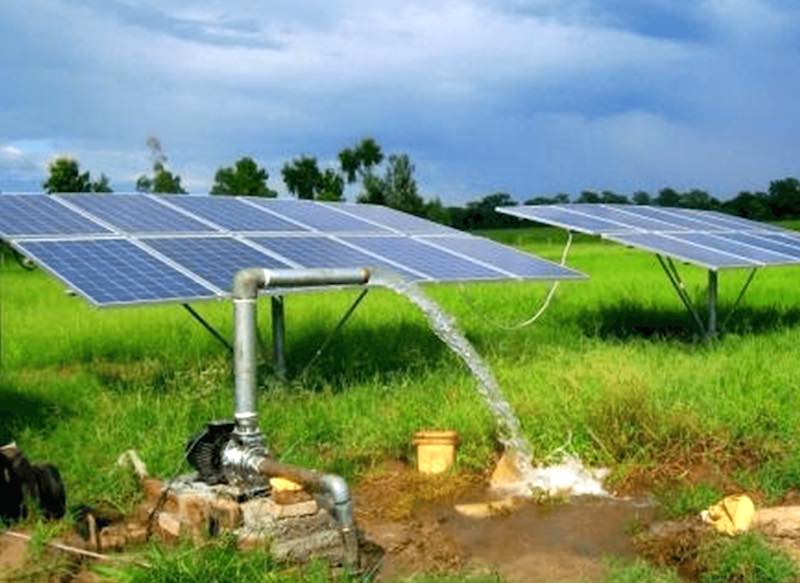Water is life, and solar water pumping may be a way to harness that life in the future!
According to WWF, only 3% of the world’s water is freshwater, and 2/3 of that is frozen into glaciers, making it a critical natural resource with a high risk of scarcity in the coming years. Currently, 1.1 billion people lack access to fresh water.
Conversely, a US citizen utilizes more than 380 liters of clean water daily. This is compared to 75 liters per day in Ghana. Most of that is for showering (20%), toilet flushing (24%) or washing clothes/dishes (36%), and leaks (12%).
You might think those figures are already pretty significant. However, this is only the tip of the iceberg. If we break down the total freshwater consumption, we find out that:
- 11% is for domestic use
- 19% is for industrial use
- 70% is for agricultural use
This raises the question, where does solar water pumping come into play, and how can it benefit us in the long run?
Let’s see how we can combine solar energy and water pumping in a solar pumping system to get water anywhere on the planet.
Table of Contents
What Is Solar Water Pumping?
Solar water pumping involves extracting water from a source (well, pond, river, storage tank, etc.) using the sun’s energy.
Let’s see how we came up with this system after thousands of years of water pumping.
The water wells were first thought to be used 8000 years ago. Water extraction was purely mechanical at this time, for example, with buckets and ropes.

The Egyptians developed the first massive irrigation systems more than 2700 years ago.
They took the form of an aqueduct.
Aqueducts are artificial water channels; they take advantage of the difference in elevation between the source of water and its point of use (potential energy difference). This technique quickly shows limits as it depends on the land’s elevation.

During the same period, the Egyptians invented the first pumping system, the Archimed screw pump (wrongly attributed to Archimed). A screw-shaped surface inside a pipe elevates the water when a rotary movement is applied.
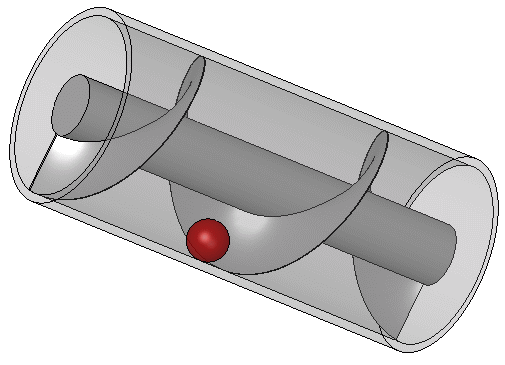
Source: Siberwolf
The energy needed to rotate the screw can originate from human strength, animals, or later, from motors powered by fossil fuels and electricity.
A Natural Source Of Energy To Power A Pump
Around 1000 years ago, the world-famous Dutch windmill was the first system to use a natural source of energy for water pumping, the wind! This is wind-pumping.
More recently, solar cells were developed in the second half of the 20th century. They use the photoelectric effect to convert the sun’s energy into electricity.
Over the last 50 years, tremendous scientific research efforts have brought to the world highly efficient solar panels that are now proven reliable and durable energy production systems.
The Birth Of Solar Water Pumping
In the late ’70s, the first-ever reported solar pumping system was introduced, coupling solar panels with a DC water pump.
This pump is a versatile technology that can be applied to domestic, agricultural, and industrial use.
Solar Water Pumping For Agricultural Irrigation
Solar pumps have gained traction recently due to the non-availability of electricity, the high cost of fossil fuels, and the global water demand. Moreover, they are one of the most promising applications of solar energy.
Irrigation mainly occurs during the dry season, i.e., summertime, when solar irradiation is at its maximum intensity. Consequently, solar energy production is also at its peak, and more water can be pumped.
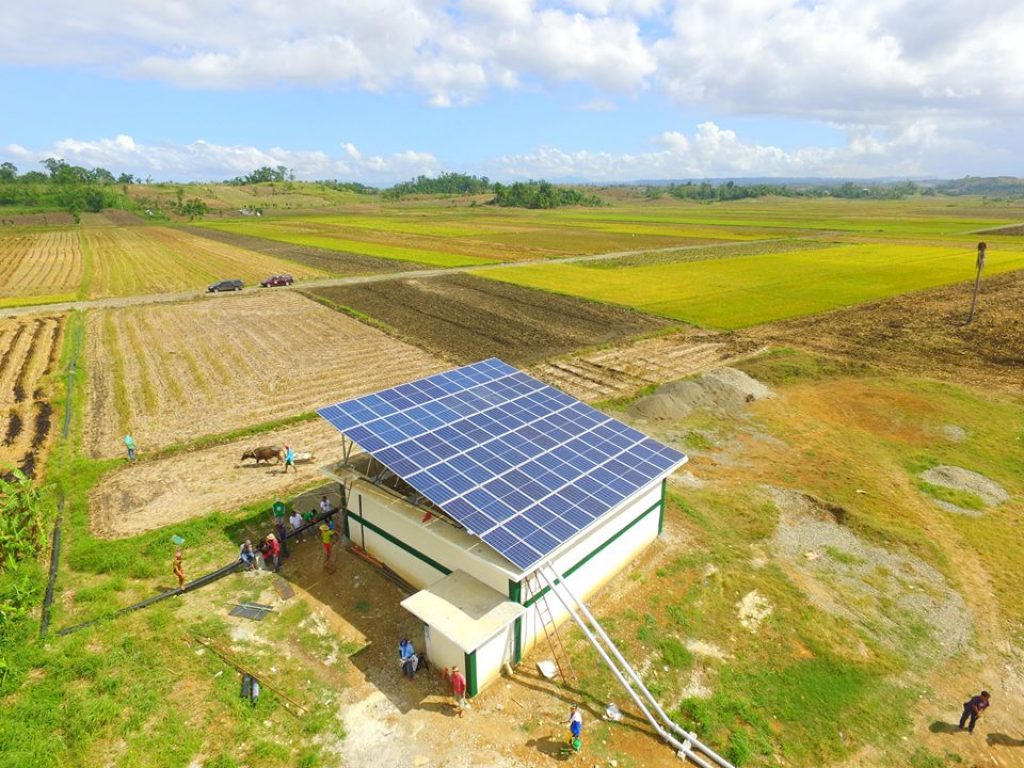
Source: National Irrigation Administration
Solar pumps are standalone systems, meaning they will operate with no connection to the electricity grid. Therefore, they are perfectly adequate for agricultural irrigation in remote areas.
Solar Water Pumping As A Circulation Pump For Domestic Use
If you have a campervan, you might be familiar with the small circulation pump that brings water from the tank to your faucet.
This is a DC pump connected to your vehicle battery, and you can run it entirely on solar energy.
You can also equip your pool or pond with a solar-powered filtration pump.

You will find a handful of scientific literature showing that solar-powered water pumping systems are more reliable and price competitive (cheaper!) compared to diesel water pumps for all use.
How Does Solar Water Pumping Work?
Your solar panel will transform the sun’s energy into electricity (DC); the electricity is then converted into mechanical energy by the motor of your DC water pump.

Source: World Bank Group
A solar pumping system consists of the following elements:
- Solar panel array
- Solar charge controller (MPPT type)
- DC Water pump
- Electrical safety equipment (fuse box, breakers)
- Electrical wiring
- Water storage (tank, cistern, etc.)
You want to select them carefully to improve the overall efficiency of your solar water pump system.
Let’s take a deeper look into the components and choose the best one suited to your needs.
Don’t forget that your solar pumping system operates in DC (direct current) mode.
Choose The Most Efficient Solar Panel Array, Optimize Its Orientation, And Avoid Shadowing
When operating solar pumps, you use the sun as your energy source.
Our sun is beautiful; it shines all year long and offers an abundant energy source everywhere on the planet. However, its intensity varies dramatically throughout the day and depends on climatic events (cloud, rain, snow).
The widely available silicon solar panels produce direct current (DC) — they love direct sunlight so ensure your solar panel is favorably oriented.
The solar atlas provides valuable information about your optimal tilting angle.
Choose A MPPT Solar Charge Controller
MPPT means Maximum Power Point Tracking — this technology will help you get the most out of your solar panel.
The sun’s power varies daily — a passing cloud can dramatically change your voltage and intensity output. This results in a difference between your solar panel output and the requirements of your DC water pump — the MPPT will help solve this mismatch.
Choose A DC Water Pump
Avoid AC water pumps; they will add complexity and reduce the total efficiency of your solar pumping system.
On the other hand, DC pumps are very efficient; on average, they use 50% less energy than AC pumps. Some models, like the centrifugal pump, can match the power output of your solar panel. Therefore, it will even operate in lower light conditions.
Store Your Water For On-Demand Use
Adding water storage capacities to your system is a must. You will gain flexibility and will avoid installing batteries.
We advise you to install 2 to 3 days, worth of water. You could use your water and cloudy/overcast days at night.
In the end, the performance of your solar pumping system will depend on the following:
- Solar radiation availability at your location
- Total head elevation of your system
- The flow of water required
- The total quantity of water to cover your needs per day
How Much Is A Solar Water Pump?
Solar water pumps are incredibly versatile systems; they are scalable from the microcirculation pump of your campervan to the massive pumping stations to meet the needs of a city. As such, the price of your system will vary.
Below are some price indications for 3 main applications of solar water pumping:
| Application of solar pump system | Power of the DC pump | Power of the solar panel array | Water pumping capacity per day | Water lift | Price |
|---|---|---|---|---|---|
| Campervan circulation | 80 W | 100 W | 500 liters | 3-5 meters | +200 USD |
| Domestic pool or water well | 500 W + | 600 W + | 2 to 60 m3 | Up to 50 meters | +1500 USD |
| Industrial and agricultural | Several kW | Several KW | +100 m3 | +100 meters | +10k USD |
Most solar pump systems require low maintenance. Several case studies have proved that those systems are economically viable compared to diesel pumping and grid-tied water pumps.
You might want to ask yourself the following questions to design the solar pumping system that will meet your needs and fit into your budget:
- What quantity of water do I need every day?
- When do I need water?
- What water flow/pressure do I need?
- How many meters must I lift the water from the source to the head of the storage tank? (this is the total dynamic head elevation)
- What is the capacity of my storage tank?
- What is the quality of my water (could it damage the pump?)
Let’s study some real-life cases to estimate the cost of a system.
The Camper Van
One of the smallest solar water pumping systems that you can design is for a camper van or a boat water circulation pump.
In this instance, your needs are limited to a few hundred liters per day at low pressure.
A typical water circulation pump is rated at 60W of power and can be powered by a 100-watt solar panel.
Below is an average price breakdown of the comp
Average Price Of Components
| Solar panel | $110 |
| DC water circulation pump | $30 |
| MPPT solar charger | $25 |
| Wiring, electrical safety equipment | $35 |
| Total | $200 |
For more comfort, you might want to connect the solar pump to your battery; therefore, you can use it at night and even charge the battery with the excess electricity produced by your panel.
The Pool Pump
You can save a lot of money with a solar pool water pump!
Water filtration of a swimming pool is one of the most suitable applications for a solar pumping system.
- Continuous operation is not needed
- The quantity of water that will circulate every day is fixed
- Pumping is only required during the day
- The total head elevation rarely excess 2m
- You will save money
Let’s see why you should switch to solar water pumping for your swimming pool:
For a 10 meters long, 5 meters wide, and 1.5 meters deep swimming pool (75 m3 ), it is recommended to have a pump capacity of 17m3/h. Usually, a regular AC water pump of 1.1Kw will do the job.
On average, you need to filter the whole swimming pool every day. In our example, this would mean 5 working hours per day at full power of the pump.
DC solar pumps are 30% to 50% more efficient than AC relatives.
Therefore, a 500W DC pump is the best for a swimming pool filtration pump.
Depending on your location on the planet, you might want to couple your DC pump with an 800W solar panel array. For the same pump, you will need 700W of solar panel in Spain, 900W in Canada, and only 600W in California.
Average Price Of Components
| 6x Solar panel | $660 |
| 500W DC pool pump | $690 |
| MPPT solar charger | Included in the dc pump kit |
| Wiring, electrical safety equipment | $100 |
| Mounting rail for solar panels | $150 |
| Total | $1600 |
Let’s see how much money you could save from switching to solar water pumping for your swimming pool.
| Regular AC grid-tied pool pump | DC Solar pumping system | |
| Running time per day | 5 hours | 5 hours+ (depending on weather conditions) |
| Max. power of the pump | 1.1 kW | 0.5 kW |
| Energy consumed per day | 5.5kWh | 2.5kWh |
| Cost of operation per day (25.59cents/kWh) California May 2022 | $1.41 | $0 |
Suppose we consider the cost of the solar energy production system alone to be around $850. The payback time of the solar water pumping system is less than 2 years.
Given that your solar panels will produce for more than 25 years, you will save more than $10,000 over the lifetime of your panels!
Related Reading: Heating Your Pool With Solar Panels (All you need to know)
The Deep Well Pump
Deep well pumping is the most common way to harvest water for daily human use. Solar water pumping will perform well for domestic, industrial, and agricultural well pumping.
Additionally, you may want to equip your system with a water cistern that has 2 to 3 days’ worth of water in case of bad weather, which would reduce the global output of your system.
Alternatively, set yourself up with a DIY greywater or rainwater collection system.
Related Reading: 10 Best Rain Barrels (Buyers Guide)
Cost Of A Solar Pumping System For A Family Of 4
A family of 4 people will consume 1 m3/day of fresh water on average. A 500W DC pump will cover the daily needs.
If the well is 30 meters deep and the domestic cistern 15 meters high from the surface, a typical domestic solar pump system will exhibit a flow of 10L/min.
Therefore the solar pump could only run 100 min every day at full power to meet the family’s needs.
Our energy source is the sun; the sunlight power will vary during the day; consequently, the power output (and the water flow) will also fluctuate.
In California, 600W of solar panels will cover your daily needs. Let’s break down the cost of your domestic solar water pumping system:
| 6x Solar panel | $660 |
| 500W deep well pump | $600 |
| MPPT solar charger | Included in the dc pump kit |
| Wiring, electrical safety equipment | $100 |
| Mounting rail for solar panels | $150 |
| Total | $1510 |
Deep-Well Solar Pump Savings
Let’s look at how much you can save using a deep-well solar pump.
| Regular AC grid tided pump | DC Solar pumping system | |
| Running time per day | 1.6 hours | 1.6 hours+ (depending on weather conditions) |
| Max. power of the pump | 1.1 kW | 0.5 kW |
| Energy consumed per day | 1.76kWh | 0.8kWh |
| Cost of operation per day (25.59cents/kWh) California May 2022 | $0.45 | $0 |
Suppose we consider the cost of the solar energy production system alone to be around $850. The payback time of the solar water pumping system is 5 years.
Given that your solar panels will produce for more than 25 years, you will save more than $2,500 over the lifetime of your panels.
Please note: a solar pump’s daily capacity production can exceed a family’s needs — this system can produce on average up to three times more than a family requires.
How High Can A Solar Pump Lift Water?
A 500W DC solar pump will commonly exhibit total dynamic pump head values of 80m to 100m.
The DC water pump is one of the main elements of your solar pumping system. DC water pumps are highly efficient systems (50% more efficient than AC pumps).
Like every water pump, its flow is closely related to the pumping elevation. This is a critical parameter for deep well pumping.
Manufacturers commonly use the total dynamic pump head (TDH) to rate their systems.
To calculate your total dynamic pump head, you will need to know:
- Static head: the distance between the depth of your water pump to the top of your water tank)
- Friction loss: the loss in pressure due to the friction of the water in your pipes. This is closely related to the length, the diameter, and the configuration of your piping system (elbow, curve, etc.). Estimate your friction loss here.
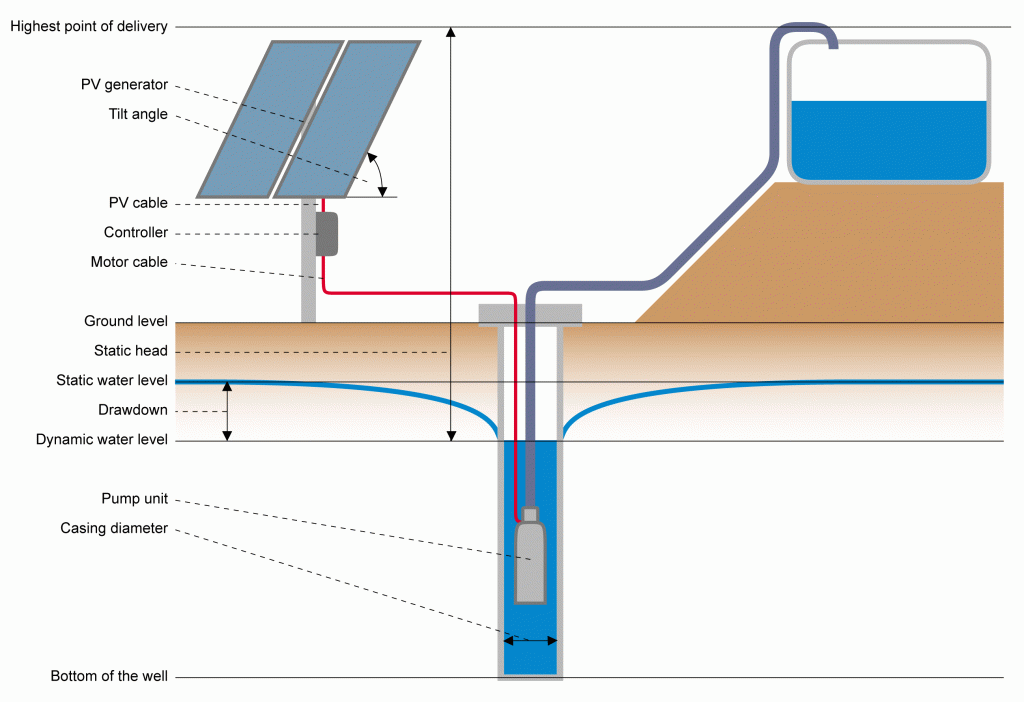
Example
- Static head: 30 meters underground + 10 meters above the ground = 40 meters.
- Friction loss in 32mm pipe: 15m. Therefore, your total pump head is 55m.
What Are The Best Solar Water Pumps?
DC pumps are the best pumps for a solar water pumping system. They are 50% more efficient than an AC water pump.
Your best choice will be a DC centrifugal pump; let’s see why:
The central body part of your DC pump is built using high-quality, low-lead marine grade bronze and stainless steel. It is designed to be corrosion-free and to require low maintenance.
Types Of Solar Water Pumps
We can classify the solar water pumps into 3 types depending on their applications:
- Submersible for deep well.
- Surface for shallow wells, ponds, rivers, springs, tanks, and in-line or floating pumps.
- Floating or in-line pumps for applications that don’t require a high lift, like water filtration in a swimming pool, water circulation for a pond, or a house.
DC water pumps are divided into 2 primary groups based on their operation principle:
- Centrifugal pump
- Positive displacement pump
A positive displacement pump will use a set of pistons and diaphragm to force a specific quantity of water in a chamber and expulse it at the end of the outlet. They require more maintenance than the centrifugal pump.
Centrifugal pumps use a spinning impeller to force the water into the pipe; they can match their power with the output of your solar panel. They will still operate under low light conditions.
Related Reading: Heating Your Pool With Solar Panels (All you need to know)
How Can I Get A Subsidy For A Solar Water Pump?
Solar water pumping is more economically viable over the long term than grid-tied water pumping. It does, however, require extra investment compared to a regular system. This is primarily due to the cost of the solar panel.
India is one of the only countries promoting installing solar pumps for agricultural irrigation and offering subsidies to finance the system.
If you cannot get a grant for your solar water pump, you might still need public assistance to purchase your solar panels. Numerous countries offer incentives in the form of preferential feed-in tariffs or tax exemptions when you install solar panels at home.
Can You Run A Water Pump With Solar?
A solar panel array can run a water pump — the DC electricity produced by the solar panel will power a DC water pump.
The first system was introduced in the ’70s — the technology is now widely used in remote areas with no grid connection.
The ever-decreasing price of solar panels makes solar water pumping technology accessible.
Systems can be designed from the smallest capacity circulation pump to the swimming pool filtering solar pump and even industrial systems for massive irrigation.
Your solar pumping system will also operate differently compared to grid-tied AC pumping, as the sun is an intermittent source of energy — its power fluctuates during the day. Consequently, the water flow of your water pump will also vary.
Can Solar Power Run A Well Pump?
Solar power can run any well-pump.
There are 2 types of wells:
- Shallow or surface well (up to 20 meters in depth)
- Deep well (more than 20 meters depth)
The submersible DC pump is the best for a deep well — it can lift water to high elevation yet with a strong flow. In the case of a shallow well, choose a surface pump.
How Deep Can A Solar Pump Work?
Solar water pumps for domestic use can work as deep as 100m, but they will perform better at 30m. Keep in mind that the water flow is closely related to the depth of operation.
The deeper you need to pump, the lower your water pressure will be.
Manufacturers usually provide the water flow of their system at different total pump head elevations.
5 Benefits Of Solar Powered Pumps
Here are the 5 benefits of a solar-powered water pump:
- They don’t require electricity grid connection (standalone systems)
- You will save a lot of money while operating them (cost competitive)
- Solar pumps are versatile and maintenance-free (from micro pumping to industrial/agricultural irrigation systems)
- They are more eco-friendly as you will operate them with 100% renewable energy
- They are energy efficient (up to 50% more efficient than an AC pump)
What Are The Best Solar Water Pump Kits For Fountains?
Fountains and ponds not only bring peace and harmony to your garden but also boost biodiversity by providing a source of water for insects, birds, and other animals.
Thanks to solar water pump kits, you can now easily install a fountain in your garden in a blink of an eye.
Let’s have a closer look at what you get when buying a solar fountain kit.
Solar fountain kits have several components, including:
- DC solar water pump
- Solar panel
- Electrical connectors
- Water fittings and nozzles
As an option, some kits might also offer battery backup.
To choose the best solar fountain, first look at the solar pump power:
- For a bird bath and small basin: 2-10 watts is best.
- For ponds and fish tanks, 15 – 100 watts is adequate.
Best solar fountain kit for bird bath
The Gocheer solar fountain has a very clever design, the solar panels are built-in and cover all the top of the fountain, and the battery is embedded in the fountain.

This solar fountain for bird bath is a ready-to-use kit, it floats on top of the water, and will work for 3-4h with no sun thanks to the built-in battery.
Depending on the power of the sun, your fountain height will vary between 10 and 60 cm.
Product Overview
A great ready-to-use solar fountain for a bird bath that will work even during cloudy days thanks to its built-in battery. Be sure to have a large basin to avoid water spillage and expose your solar fountain to full sun to maximize the water flow.
Best solar fountain kit for ponds
Solariver™ Solar Water Pump Kit 900
Solariver is a US company that was created from a small landscaping business. Based on their field experience they offer reliable and robust systems from solar fountains for bird baths to solar pumps for livestock.
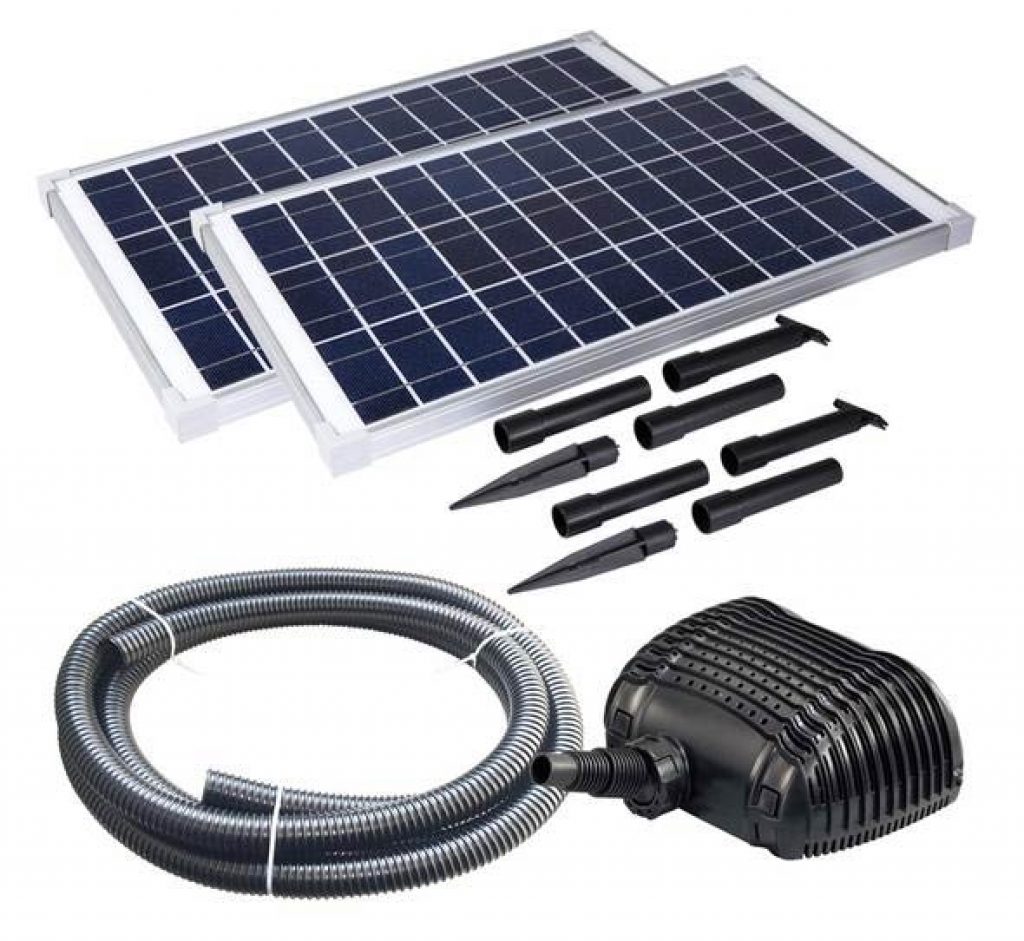
We are highlighting their 35-watt solar water pump kit that includes:
- 2 solar panels of 35 watts each
- 35W submersible DC water pump
- Flexible tubes, nozzle, wirings, and connectors
Product Overview
This solar pump kit is perfect for larger ponds (circulation and fountain), DIY solar waterfalls, and aquaculture. It moves large quantities of water, with a flow of up to 900Gal/h. In addition, thanks to the two solar panels the pump will even work in low light.
Final Thoughts
When cultivating a vegetable garden, you know your harvest yield increases when watering the plants. Indeed, irrigated agriculture will produce, on average, 2 times more than rainfed agriculture (for the same plot size).
Only 20% of the total cultivated land is currently irrigated, producing 40% of the global food stock. Water is, therefore, the most critical input for agriculture, and its consumption is expected to increase mainly as agricultural production is forecasted to expand by 70% by 2050, together with population growth.
Water and energy are closely related. Through hydropower (in artificial dams or a river flow), water can help us produce clean energy. Conversely, power is required to extract water from a well.
One energy source is available on every part of the planet — this is the sun!
We might not all have a deep well in our garden. However, lots of our readers own a swimming pool, and solar pumping for pool filtering is probably one of the most economically viable applications of the solar pump.
We recommend you convert to solar water pumping now!

